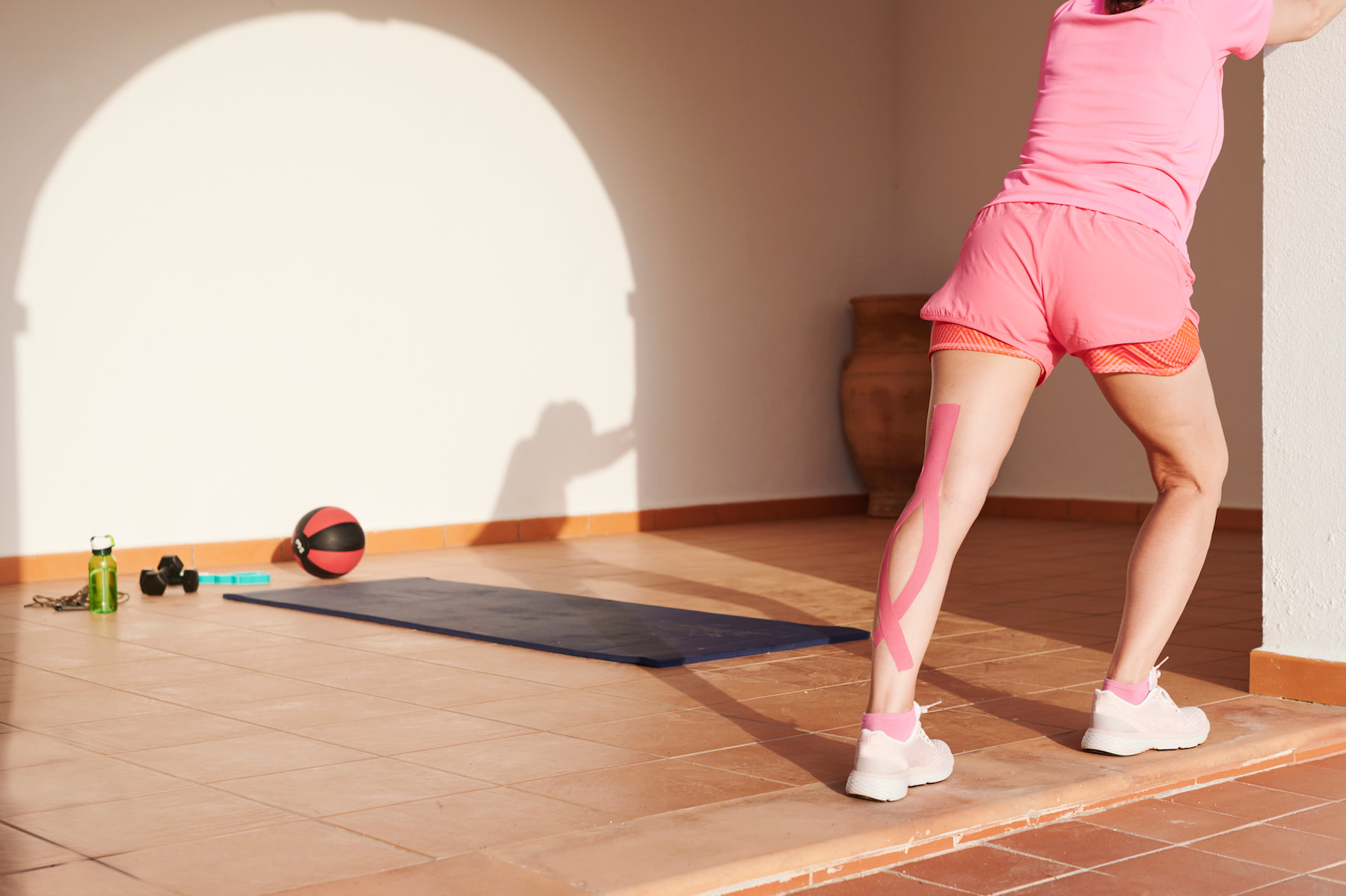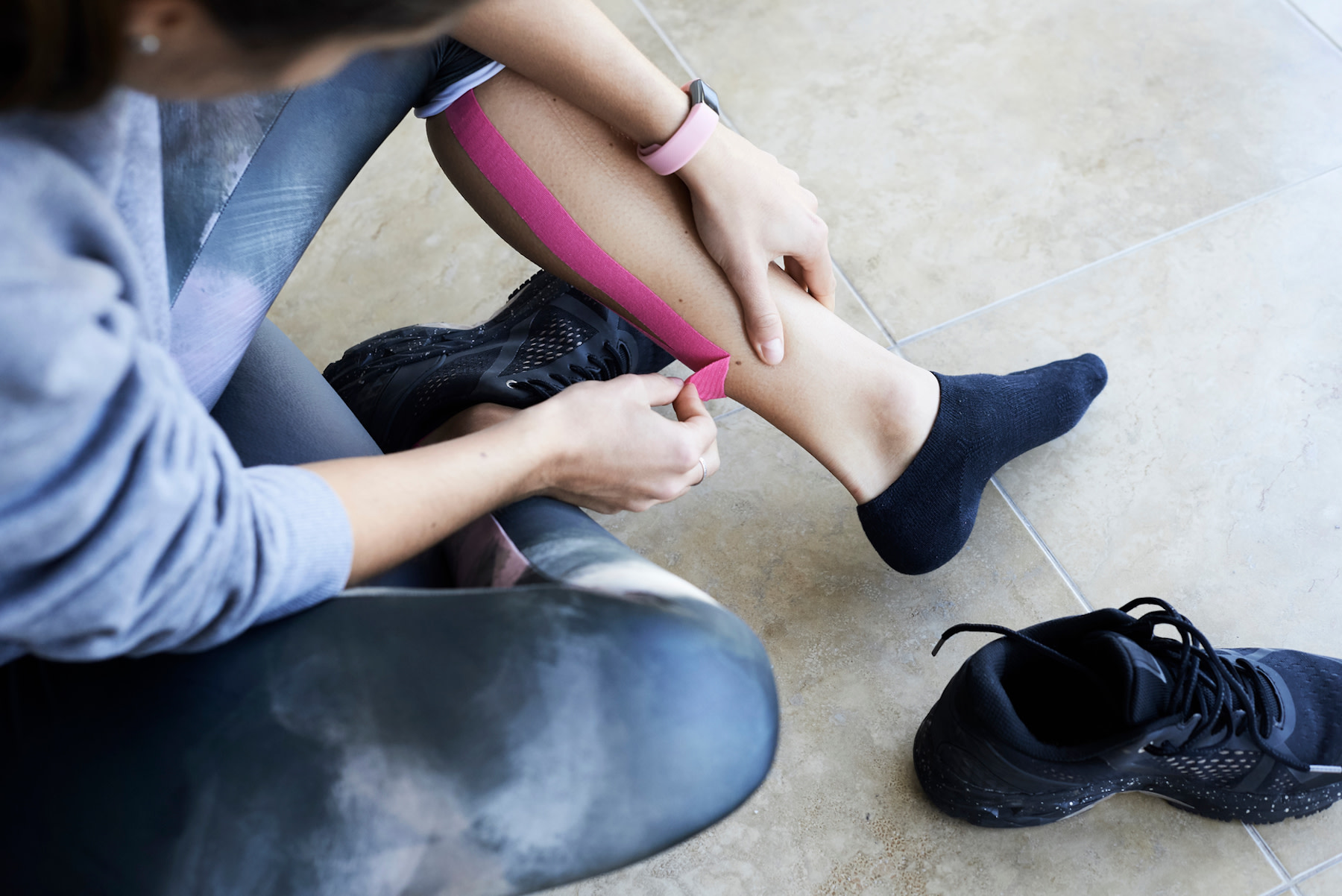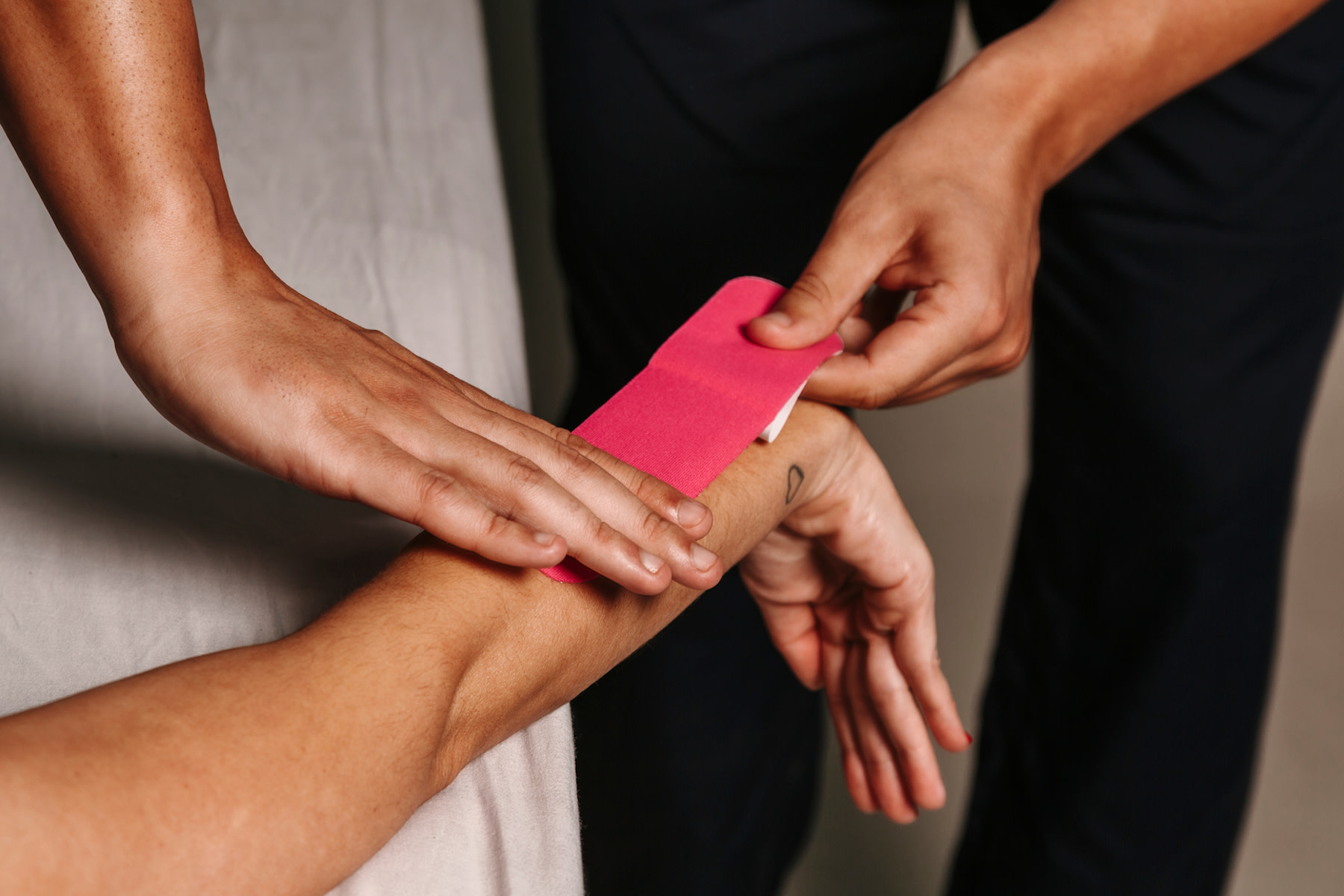
How Does Kinesiology Tape Work & Can It Help Your Workouts?
Physical therapists swear by this simple tool to support mobility challenges, performance, and more.
By Karla Walsh•
What Is Kinesiology Tape?
What Does KT Tape Do, and How Can It Support Your Workouts?
Types of Kinesiology Tape Shapes
How to Apply Kinesiology Tape
How to Take Off Kinesiology Tape
When Should You Not Use KT Tape?
The Takeaway
When you think of scoring workout support, your brain may leap to things like accountability buddies, keeping a fitness journal, or even doing a specific training program. But sometimes, our bodies need physical support, too. That’s where tools like compression sleeves or kinesiology tape come in.
Discover more ways to reach your goals with Peloton
You may have spotted kinesiology tape, sometimes called “KT tape,” on more and more athletes over the years, but it’s not only for pros. There are many reasons why you might want to give it a try for extra support, and even more ways to apply it.
So how does kinesiology tape work, and is it right for you? We tapped doctors of physical therapy to share the details on when to try KT tape and mistakes to avoid when putting it on or taking it off.
What Is Kinesiology Tape?

“Kinesiology tape (KT) is a therapeutic tape that’s applied strategically to the body to provide support, lessen pain, reduce swelling, and improve performance,” explains Wanda Evans, PT, DPT, a Washington, D.C.-based physical therapist, certified kinesio taping practitioner and a senior specialist in health policy and payment with the American Physical Therapy Association.
While KT tape is made by several brands (available online and at sporting goods stores, as well as some drug stores and major retailers), most are made of a stretchy cotton-based material that’s fast drying.
“You’re typically able to wear the tape for a couple of days before removing or changing it,” Evans says.
What Does KT Tape Do, and How Can It Support Your Workouts?
Due to its elastic nature, “kinesiology tape can affect range of motion—assisting or limiting it—strength, swelling, and pain,” adds Philip Lee, PT, DPT, OCS, physical therapist and board-certified orthopedic specialist at Swedish Hospital in Chicago, Illinois.
You might be most familiar with seeing it on runners or football players, however, Lee believes that “KT tape can assist with all fitness activities. The direction, length, and tension of the KT tape can be changed to achieve the desired effect.”
What is KT Tape Used For?
How does kinesiology tape work, exactly? The tension and additional support the material offers can assist with limited range of motion and decrease pain to improve workout performance, Lee says. As a result, you may be able to work out longer and/or harder.
Although it’s available “over the counter,” if you will, Evans and Lee agree that kinesiology tape is best used under the guidance of a physical therapist or doctor.
“A physical therapist or other qualified healthcare provider would be best to advise if kinesiology tape is needed in your workouts,” Evans explains. “Under physical therapist treatment, kinesiology tape is considered a ‘biophysical agent,’ which is used to enhance treatment goals and return to sports. A physical therapist would apply the tape if appropriate, and could also teach you how to apply the tape at home.”
Generally, kinesiology tape is used for injuries or support for someone doing repetitive motions, like beach volleyball, baseball, tennis, or football players. It’s especially beneficial for these populations because KT tape offers extra support for the joints and can increase flexibility. It can also be used to help decrease pain.
Beyond active individuals, people who deal with symptoms of certain medical conditions, including shoulder impingement and arthritis, may be able to experience greater pain-free range of motion if they use KT tape, Lee says. And people who have pre-existing injuries during fitness activities such as calf strain, tennis, or golfer's elbow, shin splints and groin pulls, or joint and tissue dysfunction such as frozen shoulder, Achilles tendonitis, and plantar fasciitis might feel some relief, too.
A physical therapist would likely use kinesiology tape as part of a multifaceted treatment program that also includes other kinds of physical therapy (as well as rest and recovery).
How Does It Differ From Other Athletic Tape?
There are a few key differences between traditional athletic tape and kinesiology tape.
Stretch. Athletic tape is normally used to limit or inhibit range of motion and to keep a joint very stable, Lee explains. The flexibility of kinesiology tape “makes it so you’re able to maintain function. Athletic tape does not generally offer as much flexibility, as it’s meant to limit motion,” Evans says.
Layers. Athletic tape is stickier than KT tape and requires a “pre-wrap” to protect the skin. Athletic tape is often used for athletic practices or competitions, Lee says. It’s quite challenging to apply—and remove. KT tape is more user-friendly and therefore can be used more frequently.
Purpose. Unlike kinesiology tape, which can be used for increasing mobility, “athletic tape is often used to limit range of motion. It can also be applied therapeutically for pain,” Lee adds.
Types of Kinesiology Tape Shapes
Kinesiology tape can be applied in a variety of shapes, which are often explained by the letters they resemble. “X,” “Y,” “I,” “H,” and “V” are common patterns. Physical therapists start by making the “I” shape, then modify from there to support the joint or improve function, Evans says.
“The shape and placement of the kinesiology tape definitely matters,” Evans confirms. “A clinical evaluation or assessment dictates the tape application and other associated treatments or modalities.”
It’s important to consult with a physical therapist before applying KT tape, especially if you’re using it for injuries or conditions. As a general rule, the best way to use KT tape to facilitate range of motion or increase muscle activation (which you might as an injury-free exerciser) would be longitudinal along the muscle, or running in the same direction of the muscle, Lee advises.
“Each muscle has different orientations, so it’s best to have someone who knows anatomy show you,” he says.
How to Apply Kinesiology Tape

Here’s how a physical therapist might walk you through how to apply kinesiology tape:
Cut the tape to a length slightly less than the amount of area you want to cover, as most kinds of kinesiology tape have at least 10 percent stretch.
Find the bottom 1 to 2 inches of tape, then rip the paper backing off of that section. This will act as your base.
Apply the base to the skin, using the opposite hand to rub the tape on top of the skin. (The adhesive is heat-activated, Lee reveals.)
With one hand holding the base down, use the other hand to pull the rest of the paper backing off, being careful that the tape doesn’t stick to anything you don’t want it to.
With that same hand on the base of the tape, now grab the opposite end of the tape and pull it along the length of the muscle you’re applying. Aim for between 10 and 40 percent stretch on the tape, depending on why and where you’re using it.
Rub the tape from top to bottom on top of the skin to help the adhesive stick.
Repeat as needed to form the shape that aligns with your goals.
(Pro tip: Take photos of each step when your PT is taping you up to make it easier to replicate at home.)
How to Take Off Kinesiology Tape
Again, it’s wise to consult with a physical therapist experienced in removing KT tape before trying it on your own.
Lee tells his clients to keep in mind that kinesiology tape is more easily removed once it’s wet. Still, even if the tape is dry, the techniques are the same.
“Start at one end and slowly roll the tape off, or simply pull it all off at once. If there is body hair, pull the tape off in the direction of the hair to minimize any discomfort,” Lee suggests.
When Should You Not Use KT Tape?
Steer clear of kinesiology tape if you have:
Thin, irritated, infected, or extremely sensitive skin
Open wounds
Allergies to adhesives
Do not use kinesiology tape over a cancer site, Lee adds, and definitely talk to your doctor before using KT tape if you’re pregnant or have been diagnosed with diabetes or heart disease.
“Your healthcare provider can discuss if it is appropriate to incorporate while you exercise, or as part of another treatment,” Evans says.
And if you’re experiencing any level of pain while exercising, believe you might have an injury or medical condition that might be affected by your workout—or have already been diagnosed with one—be sure to consult with your medical care team before working out or using kinesiology tape.
The Takeaway
Kinesiology tape is a stretchy adhesive material that can be applied in a variety of shapes to support mobility and athletic performance; decrease pain, swelling, or inflammation; or support joints and muscles. Active individuals, those undergoing therapy for certain injuries, and people with some medical conditions can benefit from using kinesiology tape. Turn to a medical professional, such as a physical therapist, before using kinesiology tape to learn where and how to apply it, plus how to remove the tape.
This content is for informational and educational purposes only and does not constitute individualized advice. It is not intended to replace professional medical evaluation, diagnosis, or treatment. Seek the advice of your physician for questions you may have regarding your health or a medical condition. If you are having a medical emergency, call your physician or 911 immediately.
This content is for informational and educational purposes only and does not constitute individualized advice. It is not intended to replace professional medical evaluation, diagnosis, or treatment. Seek the advice of your physician for questions you may have regarding your health or a medical condition. If you are having a medical emergency, call your physician or 911 immediately.
Level up your inbox.
Subscribe for a weekly dose of fitness, plus the latest promos, launches, and events.
By providing your email address, you agree to receive marketing communications from Peloton.
For more about how we use your information, see our Privacy Policy.








